From the second half of the UNC game onward, the Irish have found their stride on offense. In the last few games, Mike Brey has favored a lineup featuring Bonzie Colson has the lone big man. Since the change in the starting lineup, ND’s offense has been humming. The Irish offense scored over 80 points against Wake Forest, Florida State, Boston College, and NC State. Colson, in particular, reaped the rewards winning ACC and National Player of the Week honors after huge nights against the Deacons and Seminoles. Downshifting and playing small isn’t completely new for the Irish, but previously it was used as a change of pace. Let’s take a trip to the film room to see how going five out helps Colson and the Irish offense.
Philosophy Behind the Five Out Offense
If you’ve paid attention to basketball trends, you’ve undoubtedly heard the word “spacing.” The trend toward “space and pace”, especially in the NBA, fundamentally changed the way teams play offense at the highest levels of basketball. Last season, the Warriors “death lineup” of 6’7” Draymond Green, 6’8” Harrison Barnes, 6’6” Andre Igudala, 6’7” Klay Thompson, and 6’ 3” Steph Curry torched defenses all season long. Green is the closest thing a traditional post player in the group, but he is significantly undersized compared to seven footers that populate NBA front courts.
While the Irish still run many of the same actions they have in previous seasons, the biggest benefit to an offense going small and playing without a traditional post player is that it makes it harder for the defense to help at the rim. In traditional offenses, the big man and his defender usually camp out in the lane. If someone gets beat on the perimeter, the post defender can help to prevent an easy layup at the rim. While this leaves another player open, cascading switches and effective rotation can cover for the mistake in time for the original defender to recover. When an offense has players spaced around the three point line, helping becomes much more difficult.
If a guard is able to penetrate, a help defender has to come all the way off a shooter in the corner or wing. It’s really hard to cover this much distance quick enough to stop a layup. Additionally, helping off a good three point shooter in the corner will give the offense an open look at one of the most efficient shots in modern basketball. We can see some of these principles in action against BC from the game last Tuesday night.
Starting The Possession
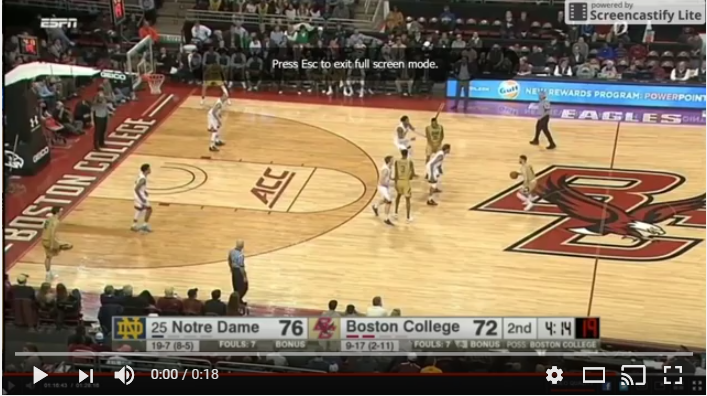
The Irish begin the possession with a “horns” look. In hoops parlance, “horns” refers to the two bigs (Colson and VJ Beachem here) setting a screen for the ball handler with the other two players spaced in the corners. In most cases, the point guard has the option of using either screen. With Farrell so far away from the corner shooters, their defenders can sag off a bit. Still, notice how much open floor their is between the restricted area and three point line. Matt Farrell goes left using Beachem’s screen, and BC immediately responds with a switch. Colson heads to the hoop, and Rex Pflueger and Beachem switch places. Beachem goes to the corner and Pflueger comes to the top of the key. Instead of being the end point of the possession, the Irish use the horns look to initiate the offense and set up early motion.
Offense Drifting in the Middle of the Possession
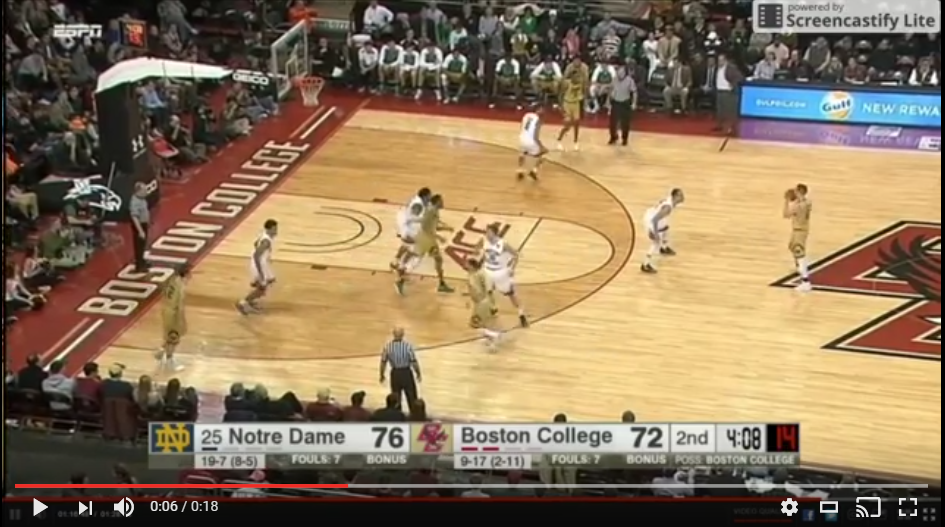
After Rex receives the pass from Farrell, things start to slow down a bit. There’s a bit of a miscommunication with Beachem coming for a dribble handoff, but Rex doesn’t recognize it. That said, there’s some good happening off the ball. Instead of standing in place, Farrell and Steve Vasturia flip places. While this isn’t a huge thing, it forces their defenders to pay attention to them. It also helps with some of the stagnation issues the Irish had earlier in the season. While there aren’t any huge moments to see while Rex has the ball, the possession takes shape when Farrell gets the ball back.
Side Pick and Roll
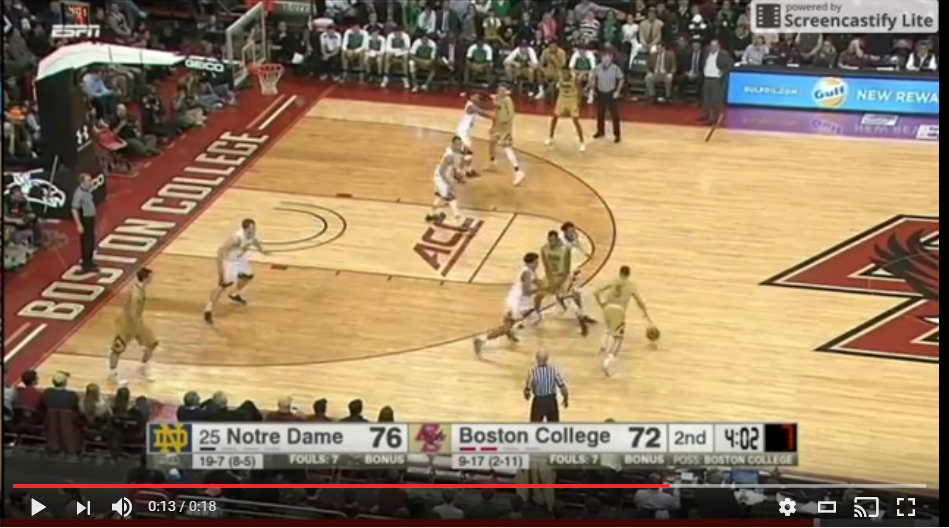
Farrell gets the ball back from Pflueger, and Bonzie comes to set a screen. This is where the 5-out offense is at its most dangerous. The other three offensive players are spaced 18 feet or more from the basket. BC has some kind of miscommunication on the ball screen; it looks like one player thought he should switch, while the other expected a hedge and recover. Since both BC’s defenders stick with Farrell off the ball screen, Bonzie immediately rolls to the rim. Vasturia properly identifies this and moves above the FT line extended into the space Colson just vacated. This is the “roll-and-replace” movement. By making that cut, Vasturia puts his man in an impossible situation. He should rotate to prevent the lay-up, but doing so would leave Vasturia alone at the three point line.
Dunk You Very Much
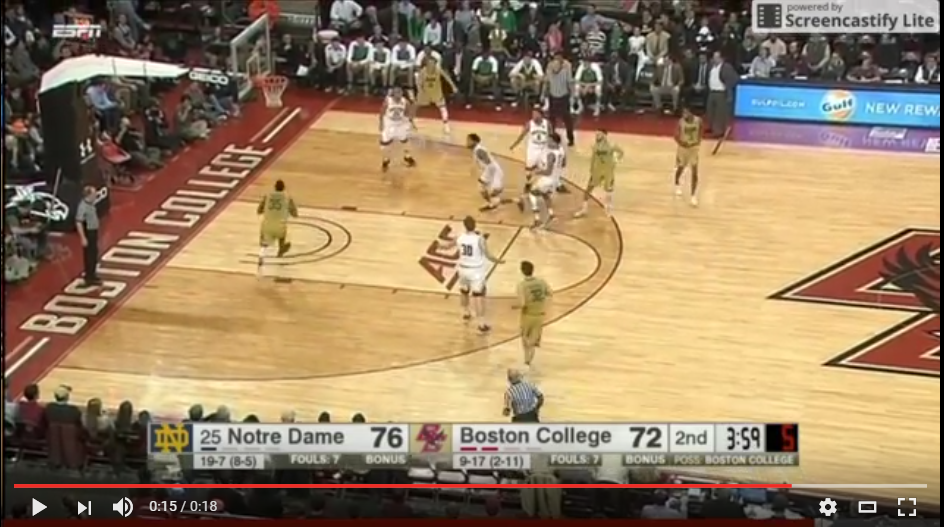
Vasturia’s man doesn’t help, and Bonzie is all alone in the paint. Because ND spaces the floor with legitimate three-point shooters at all five positions, teams are drilled not to leave Irish shooters. That keeps everyone within a step of their man on the perimeter. By sucking the defense away from the rim, the Irish are able to get easy looks like this.
When the Irish are able to space the floor, their PnR action becomes far more lethal. Mike Brey’s “downshift” line-up pulls the opponent’s rim protector away from the rim and opens up this kind of ultra-efficient offensive motion. This play is a perfect example of the collective basketball IQ Brey has built his success around.

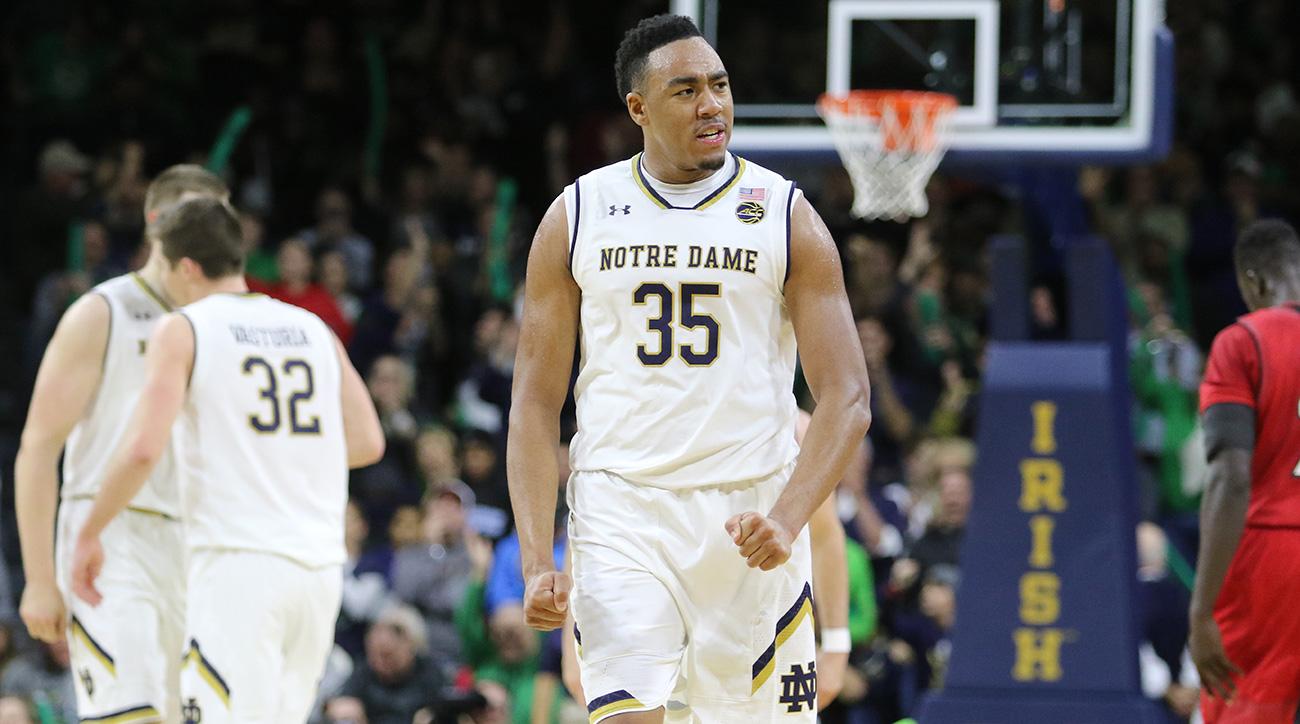

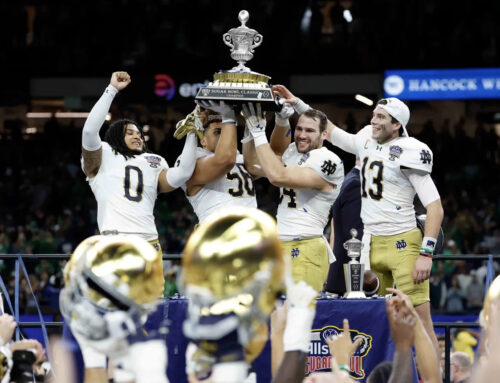

Great work. Thanks!
One thing I’ve noticed this year is that we seem to struggle at actually using the picks. I’m not sure if this is something new this year or if it’s always been the case. For example, look at the picture of Farrell using Bonzie’s pick. Because BC is terrible, they tried switching it for some reason. But a good defender would have easily fought over the top because Farrell left so much room. I seem to recall Jerian and DJ being really good at rubbing right off of Auguste, but I could be just making that up.
It would be nice to see us clean up some of this sloppy play, especially with the week of rest. I’m convinced that for us to go on a couple of tournament runs, our offensive execution is going to need to continue to get better. There’s little we can do defensively, because Farrell isn’t going to be able to handle quicker/stronger PGs, and Bonzie isn’t going to be able to contain NBA-caliber big men. That’s ok, as long as the offensive execution is at peak Brey levels.
I think that’s the critical difference between this team and the last 2. If J or DJ turned the corner on that screen cleanly, chances are you were getting dunked on. Farrell actually wants to collapse the defense and kick out. He wants to get north-south, but he’s also counting on the defense rotating to him as he makes that move. He’s definitely relying more on his quickness than the fundamentally sound way to come off that screen. Part of that is drawing the defense, part of that is necessary because of his size. You can’t question the guy’s toughness, heart, or quickness, but if you meet him – he’s not a big dude. He can get bodied off those screens. As you said, staying tight might help some of that in a well officiated game, but more often than not, he’s getting bounced around in that action.
It’s a great observation and definitely a subtle difference in how this years team uses ball screens differently. A lot of times, the previous 2 teams used them to either free a drive or the PnR action led directly to an assist. This year’s team uses it more as a means to create motion and movement that might be a pass or two away from the drive or shot.
I’ve been pleasantly surprised by the Farrell/Gibbs/Steve lineup. I didn’t think it would work much, but giving Farrell a little time off ball has worked exactly the way that letting DJ play off ball worked last year. I do wonder, though, if we don’t let Steve be the primary ball handler in those situations enough. Gibbs isn’t quite there on the pick and roll game yet, and he’s very inconsistent on getting to the rim (lots of turnovers and misses, although he is drawing a decent number of fouls). If we let Vasturia initiate, I wonder if he could do a better job of using the pick and fighting through contact to get into the paint. Let Gibbs and Farrell spot up and see if Steve can find them if the defense collapses.
Steve’s size is just such a plus for a guy with his ball handling skills. Of course, for a dude who looks like the length of the season is wearing on him, maybe asking him to spend more time fighting in the paint might be a bad idea.
For the life of me, I can’t explain why we never ball screen for Steve. Maybe it is that his drives are more crafty than purely explosive. Doesn’t make sense to me, but we’ve never done it.
If you haven’t seen it, si.com had notes about all the weaknesses of the NCAA tournament teams. They made the point that Farrell has a reputation as a guy who can’t finish at the rim. I was surprised by that…I feel he can finish but that he chooses to kick out to help the team’s offense. They also mention the small size as a negative…which by this article I also disagree with. We aren’t Golden State, but they show small ball works.
I enjoy these types of articles that break down film. Good job!